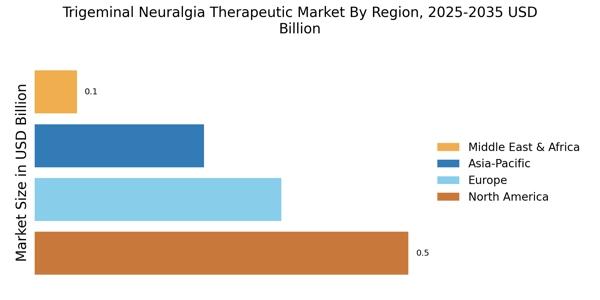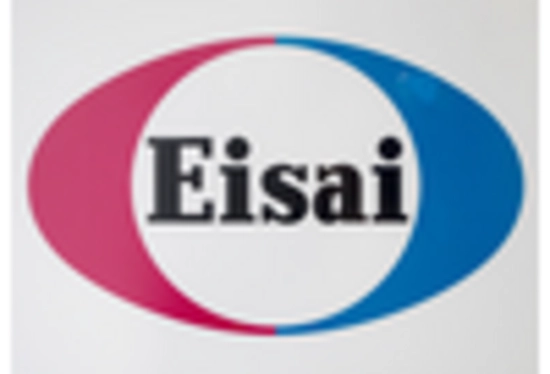Increased Awareness and Diagnosis
The heightened awareness surrounding trigeminal neuralgia is a crucial driver for the Trigeminal Neuralgia Therapeutic Market. Educational initiatives aimed at both healthcare professionals and the general public have led to improved recognition of the condition's symptoms. As a result, more patients are seeking medical attention, leading to earlier diagnosis and treatment. This trend is particularly evident in regions where healthcare access has improved, allowing for better patient outcomes. Furthermore, the integration of diagnostic tools, such as MRI and CT scans, has facilitated accurate identification of trigeminal neuralgia, thereby increasing the number of patients receiving appropriate therapies. This growing awareness is likely to sustain the momentum of the Trigeminal Neuralgia Therapeutic Market, as more individuals are treated effectively.
Advancements in Treatment Modalities
Innovations in treatment modalities are significantly influencing the Trigeminal Neuralgia Therapeutic Market. The development of novel pharmacological agents, including anticonvulsants and neuromodulators, has transformed the therapeutic landscape. For instance, medications such as carbamazepine and oxcarbazepine have shown efficacy in managing trigeminal neuralgia symptoms. Additionally, interventional techniques like microvascular decompression and stereotactic radiosurgery are gaining traction as viable treatment options. These advancements not only enhance patient outcomes but also stimulate market growth by attracting investment in research and development. The ongoing exploration of combination therapies and personalized medicine approaches further underscores the dynamic nature of the Trigeminal Neuralgia Therapeutic Market, suggesting a promising future for both patients and healthcare providers.
Patient-Centric Treatment Approaches
The shift towards patient-centric treatment approaches is reshaping the Trigeminal Neuralgia Therapeutic Market. Healthcare providers are increasingly focusing on individualized care plans that consider the unique needs and preferences of patients. This trend is evident in the development of tailored therapeutic regimens that address not only the physical aspects of trigeminal neuralgia but also the psychological impact of chronic pain. By incorporating patient feedback and outcomes into treatment strategies, providers can enhance satisfaction and adherence to therapies. Moreover, the emphasis on holistic care is likely to drive demand for complementary therapies, such as cognitive behavioral therapy and mindfulness practices, which can be integrated into traditional treatment plans. This evolution in care delivery is expected to foster growth within the Trigeminal Neuralgia Therapeutic Market.
Rising Incidence of Trigeminal Neuralgia
The increasing prevalence of trigeminal neuralgia is a primary driver for the Trigeminal Neuralgia Therapeutic Market. Recent estimates suggest that the condition affects approximately 4 to 5 individuals per 100,000 people annually. This rising incidence is likely to escalate demand for effective therapeutic options, as patients seek relief from debilitating pain. Furthermore, the aging population, which is more susceptible to neurological disorders, contributes to the growing patient base. As awareness of trigeminal neuralgia increases, healthcare providers are more likely to diagnose and treat the condition, thereby expanding the market. The need for innovative therapies that address both acute and chronic pain management is becoming increasingly apparent, indicating a robust growth trajectory for the Trigeminal Neuralgia Therapeutic Market.
Regulatory Support for Innovative Therapies
Regulatory support for innovative therapies is a pivotal factor influencing the Trigeminal Neuralgia Therapeutic Market. Regulatory agencies are increasingly recognizing the need for expedited approval processes for novel treatments that address unmet medical needs. This trend is particularly relevant for therapies targeting trigeminal neuralgia, where traditional treatment options may not suffice for all patients. Initiatives such as breakthrough therapy designations and fast-track approvals are encouraging pharmaceutical companies to invest in research and development. As a result, a pipeline of promising therapies is emerging, which could significantly alter the treatment landscape for trigeminal neuralgia. This supportive regulatory environment is likely to enhance competition and innovation within the Trigeminal Neuralgia Therapeutic Market, ultimately benefiting patients seeking effective pain relief.


















Leave a Comment